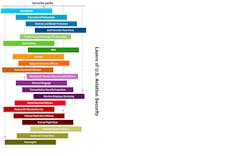I recently came across a series of media stories chiding TSA for an apparently not-so-new “security” measure in which they are testing traveler’s drinks in the sterile area – yes, the ones you bought after the screening checkpoint – and they won’t say why. I don’t intend to pursue the absurdity of the process, other than to note that if someone wants to dip a chemical test strip into my $4.23, including tax, mocha latte, he is damn well going to keep it and buy me a replacement. If they don’t trust the security-cleared Starbucks/Dunkin Donuts/Jamba Juice shops, or that nasty dark stuff from the aircraft galley, I’m not quite sure why they aren’t checking the vendors’ sources and United’s flight kitchen instead of us.
However, that’s not really where the story led me. When questioned, TSA calls on the “we can’t tell you” dodge about their twenty layers of security and un-named “random measures” when they don’t have a sensible answer. That got me thinking about where in the hierarchy of 20 does “silly” fall. They have also announced a whole new approach titled “risk-based security” (RBS), in which they intend to focus their limited resources on identifiably higher threat/risk scenarios which, to continue our theme, now apparently includes banana-nut smoothies.
The TSA web site has a spiffy color chart listing all 20 layers of security in no particular order of presumed effectiveness, proudly claiming that:
“Each one of these layers alone is capable of stopping a terrorist attack. In combination, their security value is multiplied, creating a much stronger, formidable system. A terrorist who has to overcome multiple security layers in order to carry out an attack is more likely to be pre-empted, deterred, or to fail during the attempt.”
But when we actually read the 20 layers, we find some worrisome things. Yes, some are relatively appropriate security – things I characterize as measures that you cannot not do [screening passengers and baggage, inspections for regulatory compliance, air marshals on some high threat routes, canines in some situations such as cargo]. A few are simply good administrative practices that have little to do with security [crew vetting and training]. But some are merely redundant, re-stated elements of the first all-inclusive item on the list, improved intelligence gathering (CBP, JTF, no-fly list); some have not, to my knowledge since TSA’s inception, identified a single terrorist [VIPR, BDOs]; and a couple that are otherwise questionable [such as armed flight deck officers, two of whom have, indeed, shot somebody: themselves.]
Some others kick in only after all other layers have failed – bomb appraisal officers, hardened cockpit doors, armed law enforcement officers. But the one that bothers me the most is #20 on the list, claiming TSA’s last line of protection from the forces of evil is: Passengers. You. TSA is saying, in effect, when we finish groping your granny, fingering your frappe, and juggling your junk, and the bad guys still get on board with their weapons, you’re on your own, pardner. Hand over that cappuccino; too much caffeine could kill you.
About the Author
Art Kosatka
CEO
Art Kosatka is CEO of TranSecure, an aviation consultancy in Virginia. He'll respond to questions or comments at [email protected].

